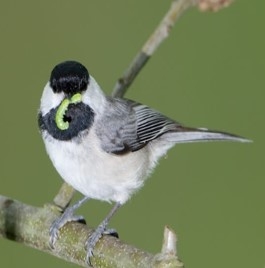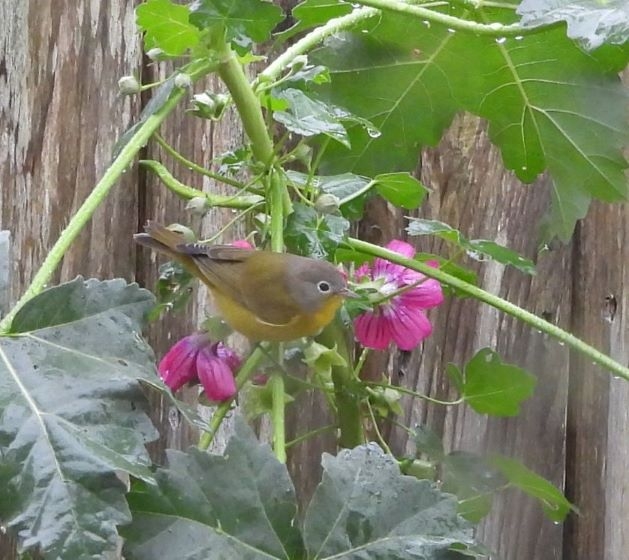
Many of us enjoy birds, but we may be inadvertently hanging “No vacancy” signs over our gardens. Research by entomologist Doug Tallamy shows that to raise their young, birds need caterpillars – lots of them. Songbirds as little as chickadees require some six to nine thousand caterpillars to raise a brood of nestlings. In fact, ninety-six percent of terrestrial songbirds rely on caterpillars to feed their babies. The prevalence of these small, soft-bodied, protein-rich larvae affects where the birds choose to nest and how big a territory they need to defend.
Fortunately, we have a good jump on knowing what these vital keystone species are. The information presented below, and the identification of keystone plant genera is based on the research of Doug Tallamy of the University of Delaware, author of Nature's Best Hope.
Here is a list of resources/databases to help you select keystone plants to support caterpillars and birds in our area:
- Calscape - Restore Nature One Garden at a Time. Enter the city where you live to see a list of native plants to choose from. You will find lots of information about each plant: images, descriptions, growth habits, and the number and types of butterflies and moths supported to name a few. (The numbers of moths and butterflies hosted indicated in the plant list below are from this search tool.)
- Audubon - Native Plants, Bring more birds to your home with native plants. Enter your zip code to see plants suited to your area and the birds they will support.
- National Wildlife Federation, Native Plant Finder Select from a list of host plants for butterflies and moths. Plants are ranked by the number of caterpillars hosted.
Using the databases above, we have put together a list of native plants that do well in our area and support butterflies and moths, which provide caterpillars to feed the birds. They all support numerous caterpillar species in our area. Numbers in parentheses indicate the probable number of caterpillar species supported.
Shrubs: Willows (211), Bitter Cherry (156), Ceanothus (85), Currants and gooseberries (85), Huckleberries (65), Wild Roses (66), Lupines (55), Manzanitas (56)
Perennials: Thimbleberry (70), Cow's Clover (67), Goldenrods (53), Beach Strawberry (32), Coast Buckwheat (31)
Annuals: Native Clovers (70), Miniature Lupine (54)
For more detailed information on these and other native plant species options for your growing conditions, visit Calscape - Restore Nature One Garden at a Time
If you would like to visit a local native garden, the North Coast CNPS, California Native Plant Society, has an extensive list of local native gardens from Trinidad to Ferndale.
Protecting The Birds That Visit Your Garden
OK! You've planted your keystone species, the caterpillars are on their way, and our feathered friends will follow. Yay!! But not surprisingly, the birds, like us, need more than just food. Here are a few steps to help you turn your avian restaurant into a home.
Reduce or eliminate pesticide use: Integrated Pest Management (IPM) strategies, such as proper plant selection, can help gardeners adopt more sustainable landscape practices.

Provide Fresh Water: Place a birdbath in the landscape and be sure to keep it clean. If you are really ambitious, a small fountain with protective plants around it will attract the birds!
Add a nest box (birdhouse) - Nest boxes can provide valuable homes for many birds For more information about nest box design and placement for specific birds visit https://nestwatch.org/learn/all-about-birdhouses/.
Keep cats indoors: Free-roaming cats kill 2-3 billion birds yearly. If you want your cat to experience the outdoors, please consider building an enclosed cat patio (catio.)
Prevent window strikes: Up to a billion birds are killed every year from collisions with windows. The site below has ideas on how to prevent these accidents.
Layer your yard's habitat:
- If you have space, consider adding large shrubs or small trees such as Bitter cherry (156), Toyon (4), Coffeeberry (23), Cascara Sagrada (27), Red Alder (70), or Vine Maple (55). These trees/shrubs not only support caterpillars but can also provide fruit and nuts, nest cavities, and perches.
- Smaller shrubs, in addition to perennials and annuals, can provide cover and seeds for birds.
- Leave some decayed leaves, twigs, and other plant debris on the ground to provide homes for invertebrates that birds eat, including the pupae of most moth caterpillars.
Leave the seeds: Do not deadhead seedheads; they can be an important food source during fall and winter. Consider planting native plants such as Woolly Sunflower (Eriophyllum lanatum), California Aster (Corethrogyne filaginifolia), and Deergrass (Muhlenbergia rigens). These plants produce a profusion of seeds that attract and support seedeaters, such as finches and sparrows.
Especially for hummingbirds:In addition to soft-bodied insects and larvae, hummingbirds can feed on nectar from most any flowering shrub, tree, vine, perennial, or annual. They are especially attracted to native species with orange, pink, and red tubular flowers, such as Humboldt County Fuchsia (Epilobium septentrionale) and Hummingbird Sage (Salvia spathacea). Manzanitas, gooseberries, and currants are important for caterpillars and can also supply nectar in the colder months.
So, what are you waiting for? Now that spring planting is near, it is time to flip that “No Vacancy” sign to “Birds are Welcome!”
For more information related to protecting birds visit:
University of California, Sustainable Landscaping in California https://anrcatalog.ucanr.edu/pdf/8504.pdf
Audubon, How to Clean a Birdbath — Attracting Birds to Your Yard | Audubon https://www.audubon.org/news/why-you-should-keep-your-birdbath-clean
NestWatch, All About Birdhouses https://nestwatch.org/learn/all-about-birdhouses/
American Bird Conservancy, Cats and Birds https://abcbirds.org/program/cats-indoors/cats-and-birds/
American Bird Conservancy, Solutions for Pet Cats, Catios and Outdoor Enclosures https://abcbirds.org/catio-solutions-cats/
Cornell Lab, All About the Birds, Why Birds Hit Windows – And How You Can Help Prevent It https://www.allaboutbirds.org/news/why-birds-hit-windows-and-how-you-can-help-prevent-it/#